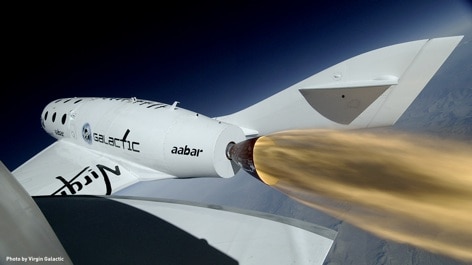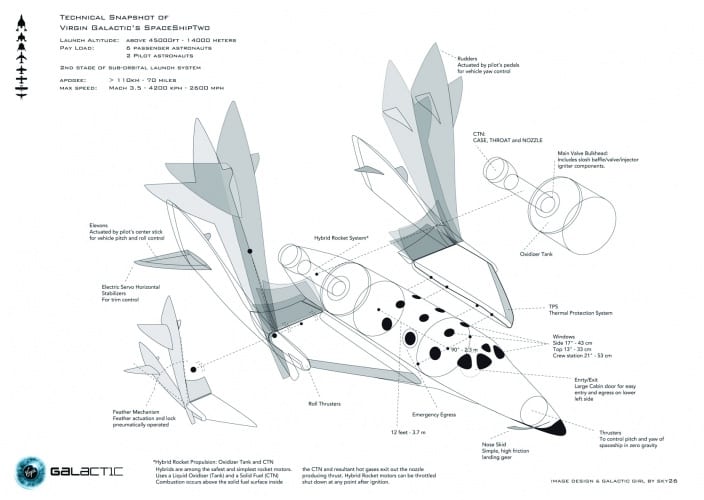Rocket science, contrary to the well-worn cliche, is quite simple. It’s mostly combustion chemistry and thermodynamics, plus Newtonian mechanics. It’s rocket engineering that’s hard.
The loss of the Scaled Composites Space Ship Two, the proposed carrier for Virgin Galactic’s space tourism thrill-rides, with the tragic death of test pilot Michael Asbury brought that fact home to us at the weekend. Combined with the explosion of the Antares rocket shortly after launch last week, it reminded us that space is hard, and it’s also dangerous.

This is something that everyone used to know. It’s easy for us to forget, when launches of vehicles like Ariane are usually successful, how tricky it is to balance a narrow vertical cylinder on top of a ball of burning gas and guide its payload into orbit, let alone to propel a capsule capable of supporting life beyond the atmosphere; but in the early days of the space race, failures were more common than successes and everyone knew the odds were stacked against the rocketeers. It gives you a renewed respect for the bravery of the first cosmonauts and astronauts, sitting up there on what Alan Shepard, pilot of Mercury mission Friendship 7, described pointedly as ‘a machine with 270,000 moving parts, every one of which was built by the lowest bidder.’
So will the loss of Space Ship Two mean the end for space tourism? We can’t say until we know what went wrong and why. Early conjecture that the engine, which was using a new solid fuel system after the original rubber fuel proved incapable of sending the machine into space, had exploded has proved incorrect, as both engine and oxidiser tank were found intact; the fault now appears to have been with the ’feathering’ system which changes the vehicle’s aerodynamics and decelerates it on reentry into the atmosphere, allowing it to land without retrorockets. This was the most innovative part of Scaled founder Burt Rutan’s design, and was vital for keeping the cost of Space Ship Two and its X-Prize winning predecessor low.
What we don’t know yet is why the system failed. It appears to have been unlocked by Alsbury while the ship was travelling too slowly but it then deployed without a control input from the pilot, and it is yet to be determined whether that was a failure of the control system, an event linked to aerodynamics or some other fault.The crash is being investigated by the National Transportation Safety Board, which oversees passenger vehicles; the fist time that the board has led the investigation of a spaceship crash, although it was involved in the invesitgation of the Space Shuttle Challenger disaster. Once its investigation is complete, which will include a report on the causes of the crash and safety recommendations for future flights, it’ll be up to the US government agency, the Federal Aviation Authority, to decide whether Scaled and Virgin will be certified to carry passengers.

So it’s certain that Virgin Galactic’s first commercial flight will be delayed while more trials take place; more delays, after Virgin chief Richard Branson’s bullish and decreasingly believable protestations that passenger flights will begin within a year which he’s now been making since 2007. It could be that Branson is now one of the company’s biggest liabilities. There is often a suspicion that some of Virgin’s initiatives are more about feeding his ego than anything else, and that he frequently promises more than his organisation is equipped to deliver.
For the Scaled team, the challenge is to push the frontiers of technology: to get it to work in the way Rutan and his fellow engineers believed it would, and for the pilots, to gain coveted ’astronaut’s wings’. They will undoubtedly want to keep going. And it certainly seems not to have discouraged Virgin’s customers so far; the company has reported that only 20 of the 700 prospective fliers who had paid deposits have asked for a refund. Branson claimed that the company was still receiving bookings after the crash; he clearly needs this to happen, because even 700 full fares for his glorified roller-coaster ride (and that’s all Virgin Galactic is; even its most ardent supporters can’t argue that it’s anything to do with exploration) won’t be sufficient for him to recoup his personal investment in the project; Virgin Group has pumped some $100million into Virgin Galactic.
Other space tourism operations haven’t said anything, but then none of them are even testing a full-scale vehicle in flight. As for commercial space, as it doesn’t use Scaled’s technologies or anything like them, the failure of Space Ship Two will be saddening but nothing more; SpaceX’s crewed missions to the ISS using its Dragon capsule remain dependent on its own technology trials.
It’s been said that space tourism will have an important influence on the future of crewed spaceflight, and certainly Rutan proved that a private company can find innovations in space vehicles that NASA couldn’t. But we’ll have to wait and see whether the effects of the Space Ship Two crash dampen the enthusiasm of the very rich to take on the freshly-emphasised risk of riding an explosion for kicks. Because ultimately, that’s what’ll determine whether space flight can make money for investors, and that’s the sole key to the future of Virgin Galactic.




Nanogenerator consumes CO2 to generate electricity
Whoopee, they've solved how to keep a light on but not a lot else.